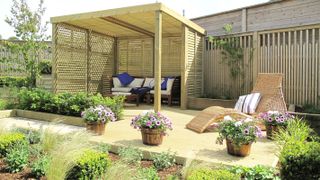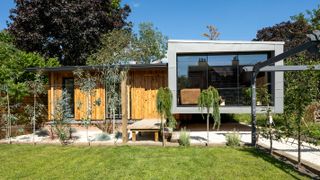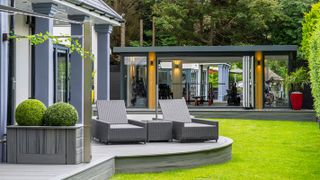Raised decking ideas to take your garden to the next level
Check out our selection of brilliant raised decking ideas — the perfect source of inspiration to help transform your garden into a space full of interest no matter what its size or style

Raised decking ideas can be the perfect solution for a number of landscaping dilemmas, helping to overcome the challenges faced by owners of sloping gardens as well as being a useful way of defining and zoning a space.
If you were thinking that decking ideas are limited to those with more modern garden design schemes then this round up should help change your mind — decking comes in all kinds of styles meaning that whether you have your heart set on a pretty cottage garden design or a contemporary masterpiece, there will be something to suit your needs.
We've rounded up our favourite ideas, from those formed using composite decking to designs forged using timber — check them out to get your garden project started.
Which raised decking ideas are right for you?
It is important to bear in mind that your decking needs to look in proportion to the size of your garden as well as any other structures or features within the space.
"Make sure you carefully plan how much of your garden you want to cover with decking," say the experts at Garden Buildings Direct. "Too little and you won’t have enough space to fit furniture and planters on. But too much and you can lose the natural feel of the garden — leaving no space for wildlife to flourish."
Before you begin formulating ideas, it is wise to familiarise yourself with how to build a raised deck.
“The first stage is planning — think about how wide you want the decking to span, and importantly how tall it needs to be," advises Allan Jeffrey, Managing Director at Ultra Decking.
Once you have a clear idea of where your deck will be located within your garden, the size you need it to be and your budget, you can begin to build up some ideas of how you want it to look.
1. Vary the heights of your decking for added interest

Brand new decking or paving can be lacking a little in character before it has had a chance to weather in, so adding in visual interest to its design will really help.
When it comes to raised decking, there is no reason why it has to be the same height all over — in fact varying the levels is a fantastic way to break up an expanse of decking. This not only works from the perspective of appearance, but also on a more practical front. Different levels helps to 'zone' the decking meaning you can have separate areas for different uses, such as dining or sunbathing.
Do make sure that you find out how to make decking non slip if you like this idea — you don't want to find yourself slipping down steps.
The decking here is composite, from Ultra Decking.
2. Use a wraparound raised deck to maximise views

One of the best uses of raised decking is to make the most of any outstanding views — if you've got them then you really want to flaunt them.
A raised deck creates an elevated platform from which to enjoy really far reaching vistas and if you are lucky enough to have a house that has views from all angles, creating a deck that wraps around the sides of the property with the best of these really makes sense.
In the case of this stunning contemporary self build, the owners have done all they can to ensure their views can be fully appreciated from all angles — along with high levels windows and plenty of glazing, a raised timber deck projecting from the rear of the property provides the perfect vantage point.
3. Form a balcony from a raised deck

Okay, it isn't exactly a raised deck but there is actually only a small difference between some types of balconies and raised decks. If you are considering constructing a raised deck then you may well like to think about adjoining it to your house in order to create a platform leading from the upper storeys of your home — effectively building a balcony.
The main difference between most raised decks and balconies is that balconies will almost always be covered with a roof and surrounded by railings or balustrades of some kind.
4. Keep railings lightweight to avoid blocking light

Depending on the height of your raised decking, railings or balustrades could be necessary in order to avoid nasty accidents from occurring. Additionally, the right decking balustrade ideas can really add a more polished 'finished' look to decking.
Make sure that whatever type of balustrading you use both ties in with the design of your deck as well as not blocking any light from the spaces inside your house. Here, the pale timber decking, laid in an eye-catching herringbone pattern, has been surrounded by lightweight railings made up of timber posts and thin metal wires.
5. Create shaded areas over your decking

Any decking, raised or otherwise, can really benefit from the addition of some patio cover ideas. Consider constructing a pergola or fitting awning over your deck — either over just one section that will most benefit from shade, or over the whole thing.
Here, the timber deck has been split into various zones thanks to the clever use of a partially enclosed pergola. This has created a shady retreat, but also allows any sun worshippers the opportunity to top up their tan elsewhere on the deck. The raised planter further defines the space.
6. Inject instant character by laying decking diagonally

When it comes to how to lay decking, there is no reason at all why your decking has to be installed in straight lines — some of the most visually striking decks are created by laying decking planks in interesting patterns, such as herringbone or, as has been done here, diagonally.
While the direction that decking boards are laid in will obviously have a huge effect on the final appearance of your new feature, it can also play a part in how well it performs on a practical level.
"Install decking boards in the opposite way to the direction of travel," advises Leigh Barnes at Jacksons Fencing. "This will increase the slip resistance and give you more grip."
7. Opt for composite decking to minimise maintenance

Composite decking is a great choice for those looking for an alternative to timber — it tends to offer greater slip resistance than timber when wet which is definitely something to think about in the case of raised decking.
When it comes to wood decking vs composite, one of the main draws of composite for many people is its low maintenance requirements.
“Composite decking requires far less upkeep and maintenance than other decking options," says Allan Jeffrey, founder of Ultra Decking. "Unlike wood, it doesn’t need regular treating, staining or painting, and the colour doesn’t fade as quickly as wood."
8. Use decking to extend your spaces

Raised decking is the perfect solution for those after sloping garden ideas, avoiding the need for steps or excavating tonnes of soil and a brilliant way of connecting your interior spaces to the garden.
If you are creating an extension with glazed patio doors, or are perhaps fitting bifold or sliding doors to your existing spaces and your garden slopes away from the house, a raised deck will mean you can step seamlessly out from your house and into your garden. In warmer weather, this effectively extends your interior spaces once the doors are flung open.
9. Use a raised deck as a walkway

Raised decking does not have to be viewed only as an alternative for those previously only considering patio ideas — it can also be used to provide a more practical purpose in navigating your way around the garden.
Here, a raised deck now provides a kind of jetty, out from the small terrace and into the garden. This not only makes it easier for the homeowners to make their way out of the house and into the garden, but also adds visual interest and an additional dimension to the elevation of the house.
10. Consider a curved raised deck

Decks don't have to be square or rectangular — curved decking can look really beautiful, add interest and in some cases will be a much better solution than lots of straight lines.
Curves work well in both small and large gardens. In larger spaces they tend to soften any harsh lines, while for those seeking small garden design ideas they can be easier to navigate and take up less visual space therefore making the whole area feel bigger.
When used in the design of a raised deck, a curved area makes the space feel more private and encourages a different way of moving around the garden.
11. Paint your raised deck to give it definition

If you are going to the trouble of building a raised deck then it makes sense to ensure all eyes are drawn to it and that it stands out as a garden feature of note.
Whether you have an existing deck in need of a makeover, or are creating a new one from scratch, painting decking is a great idea — plus it could help your deck last longer by protecting it.
Do be sure to thoroughly clean your decking before you begin, sand and prime. It also makes sense to use a paint specifically for this purpose.
12. Break up a large deck with different levels

The last thing you want is for your new deck to look overwhelming and to visually dominate the rest of your garden design — and this needs to be a major consideration when building a raised deck which will obviously be set higher up than the rest of the space.
In the case of larger decks, varying the heights of the decking works to break up the look of the space and separate it out into different zones.
Here, Habitat+ Grey Composite Deck boards from B&Q have been used to create a split level area that follows the natural lines of the garden.
13. Use decking to make the most of a sunny spot

If there is one particular area of your garden that sees the best of the sunshine throughout the day then this is the one to ensure you can enjoy all year round — and what better way to do this than by creating a raised deck here?
"Adding a raised deck to the corner of your garden that gets the sun will help maximise sunlight," says Leigh Barnes, of Jacksons Fencing. "Raising the height even just by a few inches can help extend the hours of sunlight you get, and raise you above any obstructions like fence panels or trees."
14. Surround your decking with raised planters

Do consider your planting scheme alongside the creation of your raised decking — it will really bring it to life, soften the edges and can help define its boundaries. Your choice of plants can also bring out and enhance your decking colour ideas, as well as making the whole space feel more private.
Here, a raised deck leading directly off from the house, has been surrounded with matching raised planters. The dazzling white pebbles and architectural style of the plants tie in with the design perfectly.
15. Match your decking to your cladding

For a nice, uniform look, do consider the cladding materials you have used on your house if the raised deck will be attached to the property — it really will become part of the overall design and so it makes sense to tie the two together visually.
Here, this beautiful new oak frame self build, by Border Oak, features a small raised deck, accessed by French doors. Using a wood that coordinates with the timber cladding helps to bring the whole thing together perfectly.
16. Finish off a garden pond with raised decking

Garden ponds look fantastic, encourage wildlife into your garden and really bring a sense of tranquility to the spaces they grace.
In order to enjoy a pond fully, however, you want to be able to access it from all sides, no matter how wet and boggy the ground may get underfoot. For this reason, surrounding a pond with a raised deck makes so much sense.
Here, decking from Jacksons Fencing has been used not only to create a relaxing lounging area, but also as a jetty from which to take a dip in this natural swimming pool.
Get the Homebuilding & Renovating Newsletter
Bring your dream home to life with expert advice, how to guides and design inspiration. Sign up for our newsletter and get two free tickets to a Homebuilding & Renovating Show near you.
Natasha is Homebuilding & Renovating’s Associate Content Editor and has been a member of the team for over two decades. An experienced journalist and renovation expert, she has written for a number of homes titles. Over the years Natasha has renovated and carried out a side extension to a Victorian terrace. She is currently living in the rural Edwardian cottage she renovated and extended on a largely DIY basis, living on site for the duration of the project. She is now looking for her next project — something which is proving far harder than she thought it would be.
